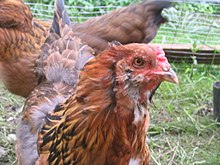Pecking order

Pecking order or peck order is the colloquial term for the hierarchical system of social organization. It was first described by Thorleif Schjelderup-Ebbe in 1921 under the German terms Hackordnung or Hackliste and introduced into English in 1927.[1]
The original use of pecking order referred to the expression of dominance in chickens. Dominance in chickens is asserted by various behaviours, including pecking, which was used by Schjelderup-Ebbe as a measure of dominance and leadership order. In his 1924 German-language article, he noted that "defense and aggression in the hen is accomplished with the beak".[2] This emphasis on pecking led many subsequent studies on fowl behaviour to use it as a primary observation, however, it has been noted that roosters tend to leap and use their claws in conflicts.[3]
The term dominance hierarchy is often used for this type of social organisation in other animals.
Pecking order is a basic concept in social stratification and social hierarchy that has its counterparts in other animal species, including humans, although the term "pecking order" is often used synonymously.
Biological theories
Function
The ultimate function of a pecking order is to increase the individual or inclusive fitness of the animals involved in its formation. Fighting to acquire resources such as food and mates is expensive in terms of time, energy and the risk of injury. By developing a pecking order, animals determine which individuals will get priority of access to resources, particularly when they are limited; there is a reduction in aggression when a pecking order has been developed. Therefore, the proximate functions of a pecking order are to reduce the costs of time, energy and risk of injury incurred during resource acquisition and defence.
Mechanism
The basic concept behind the establishment of the pecking order among, for example, chickens, is that it is necessary to determine who is the 'top chicken,' the 'bottom chicken' and where all the rest fit in between. The establishment of the dominance hierarchy may reduce the incidence of conflict and thus reduce the expenditure of energy required for aggressive competition. The dominance level determines which individual gets preferential access to resources such as food and mates.[4][circular reference]
In the wild, pecking order status is inherited along a strict basis, so that the first daughter of the most dominant chicken will inherit that most dominant status, the second most dominant will give second most dominant status to her daughter, etc. unless the most dominant chicken has a second daughter, in which case that chicken will become the second most dominant.[citation needed] Studies of the genetic basis of pecking orders in chickens have indicated that it may largely be determined by the coloration patterns.[5]
It is not necessary for animals to be able to recognise individuals within the group for a pecking order to be maintained. Animal behaviours may be motivated by "rule of thumb". For example, if chickens can predict the fighting ability of others simply by assessing their body size, they will be able to maintain the hierarchy whilst avoiding a fight which could cause injury and will be energetically costly. Using this rule of thumb, if Chicken A sees that Chicken B is larger, Chicken A will defer; if Chicken B is smaller, it will defer to Chicken A. In this way, only chickens of similar sizes will fight and the pecking order of the group overall is maintained without requiring individual recognition.
Wild and feral chickens form relatively small groups, usually including no more than 10 to 20 individuals. It has been shown that in larger groups, which is common in farming, the dominance hierarchy becomes less stable and aggression increases.[6]
See also
References
- ^ Perrin, P.G., (1955). Pecking order 1927-54. American Speech, 30(4): 265-268
- ^ Schjelderup-Ebbe, 1975 p. 36 cited in Rajecki, D.W. (1988)
- ^ Rajecki, D.W. (1988). Formation of leap orders in pairs of male domestic chickens. Aggressive Behavior, 14(6): 425-436
- ^ Biology: An Introduction. Wikimedia Foundation. p. 157.
- ^ Robert Sapolsky (April 12, 2010). Behavioral Genetics I (Human Behavioral Biology). Stanford University.
- ^ Craig, J.V. (11 May 1978). Aggressive behavior of chickens: Some effects of social and physical environments (PDF). 27th Annual National Breeder's Roundtable. Kansas City, KS, US. Retrieved 2013-08-24.
Further reading
- Schjelderup-Ebbe, T. (1975). Contributions to the social psychology of the domestic chicken [Schleidt M., Schleidt, W.M., translators]. In, Schein, M.W. (ed); "Social Hierarchy and Dominance. Benchmark Papers in Animal Behavior, Volume 3." Stroudsburg, PA: Dowden, Hutchinson and Ross, pp. 35–49. (Reprinted from Zeitschrift für Psychologie, 1922, 88:225-252.)
